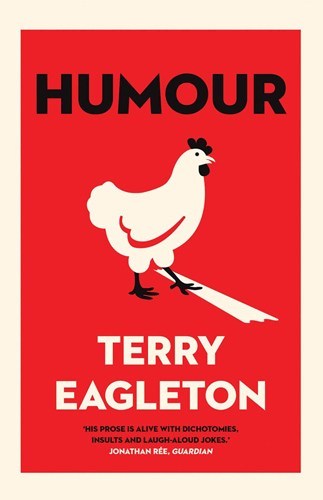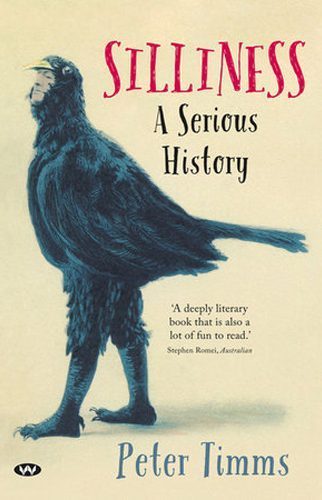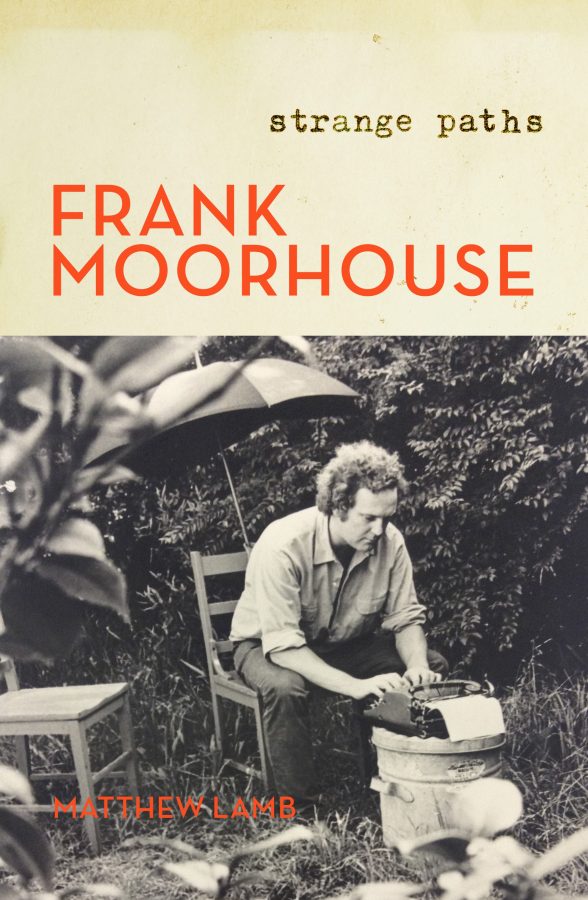Stepping on Rakes: Terry Eagleton’s Humour and Peter Timms’ Silliness
There seems to be no lengths to which humorless people will not go to analyse humor. It seems to worry them.
— Robert Benchley
What should you expect from a book about humour in 2019? Some context would be nice: a nod to the various catastrophes on the horizon. Beginning a study of humour in this way might seem counterintuitive – thus appropriate, according to comedy’s circular logic. Analysing humour is already a notorious buzzkill, so why not lean into it? Secondly, you’d think there’d be a big chapter on memes as the most recent, interesting, and revealing evolution in collective humour. From there you might segue to the problems posed by a political landscape so cartoonish it’s impervious to satire; navigating wokeness and cancellation; online insularity; lifestyle irony and post-irony as coping mechanisms; anti-comedy; why stand-up’s getting worse; why Australian stand-up was never good in the first place (at least until Aamer Rahman and Nazeem Hussain’s Fear of a Brown Planet); and so on. Surely a book about humour in 2019 would tackle some of these issues?
Terry Eagleton’s Humour and Peter Timms’ Silliness: A Serious History are two recent additions to the patchy field of humour studies. Both authors are hemmed into the Anglocentric comedy canon that sees absurdist comedy peaking with The Goon Show, Pete and Dud, and Monty Python, and going downhill ever since. They’re also both in their seventies. This puts you in the weird position of feeling unreasonable for expecting them to be up-to-date on their subject. But neither would you want their lukewarm take on, say, ‘meme commentator’ @gayvapeshark or the HBO series Los Espookys.
To be fair, cutting-edge relevancy isn’t Eagleton or Timms’ priority. Humour is a critical survey not of humour but its theory – like a literature review for a PhD, albeit more reader-friendly. Its most interesting aspect is its Marxist subtext (Eagleton’s famously a comrade), which occasionally breaks ground but never erupts into a full-blown theory of how humour can serve Leftist aims. The closest Eagleton comes is suggesting that those wielding such humour might have to play dirty, though he’s vague on the what this entails. Silliness is an armchair history, covering much of the same ground as Humour with more dad-ish pizzazz, less academic rigour and a chip on its shoulder about revolutionaries. Both do a good job of summarising the field without expanding it significantly. Nor do they mention memes. So why bother writing these books? What drives men (and it’s almost always men) to analyse humour?
Dorothy Parker, in her wonderfully snarky review of William Phelps’ Happiness (1927), quotes a passage in which Phelps claims that everyone, regardless of demographic, wants to be happy. ‘Hence,’ Phelps concludes, ‘definitions of happiness are interesting’. Parker retorts: ‘I suppose the best thing to do with that is to let it pass.’
Humour theory seems similarly premised: everyone likes to laugh, hence analyses of laughter are interesting. They better be – how else to justify them? As Eagleton points out in the introduction to Humour: ‘a good many studies of humour begin with the shamefaced acknowledgement that to analyse humour is to kill it dead’. Here he’s paraphrasing the most famous wording of this truism, by E.B. White: ‘analyzing humour is like dissecting a frog. Nobody cares and the frog dies in the process.’
Historically, humour theory is sometimes interesting in spite of itself, giving intriguing, if essentialist insights into the nature of humour, comedy, and laughter. Superiority theory, established by Aristotle, developed further by Thomas Hobbes and Charles Baudelaire (among others) and now outmoded, sees laughter as a social corrective against vice and non-conformity. Henri Bergson, in his seminal essay Laughter (1900), states that laughter comes from witnessing some quality of mechanical inelasticity in a living thing – particularly when the latter is unaware of its impediment, or is caught mid-realisation. (Bergson’s basically describing humour theory itself: something perpetually becoming aware of its own futility, yet compelled to proceed regardless.) Relief theory, outlined most famously by Sigmund Freud in Jokes and their Relation to the Unconscious (1905), prescribes laughter to release psychological tension. Incongruity theory, pioneered by a dream team of Frances Hutcheson, Arthur Schopenhauer, Georg Wilhelm Friedrich Hegel and Immanuel Kant, claims that laughter arises from the realisation of a disparity between the conceptual and material elements in a situation, requiring a sudden shift in perspective. As Eagleton and Timms both point out, incongruity is currently the most widely applicable and accepted of the totalising theories.
The philosophy of humour with which Eagleton and Timms are most enamoured – as are countless academics in disparate branches of the arts – is the carnivalesque, or grotesque realism. Coined by Mikhail Bakhtin, these terms denote humour that’s earthy, levelling, visceral, indiscriminate, regenerative, and self-derisive. As the humour of the masses, it offers a warm, rowdy counterpoint to haughty, needling, bitter satire. Admittedly, carnival originally functioned as a ‘safety valve’ for expunging mass discontent, thereby maintaining the status quo. (In modernity, carnival is reified and regulated as spectacle.) At the same time, it at least points to the possibility of revolution, and to anarchy as a cyclical, infinitely recurring necessity; hence grotesque realism. The socialistic vision of humour that Eagleton dabs at impressionistically throughout Humour is more or less carnivalesque – fiery but benevolent, under no illusions about humanity’s many faults and able to accommodate them nonetheless. What Eagleton implies repeatedly but never states outright is that this kind of empathic humour will become pronounced in the coming decades, if we’re to avoid regressing into fascism.
Humour and Silliness diverge from a lot of prior humour theory in the sense that they are unapologetic, and refrain from deconstructing jokes, anecdotes, and scenarios structurally, beyond remarking on their themes, connotations, and loose categorisation; they don’t kill jokes as such. But they’re pushy about being funny in their own right. When they are, it’s usually by accident.
‘If you want to raise a laugh it is unwise to joke and dissect your joke at the same time’, Eagleton writes in the introduction, ‘but there are not many comedians who come up with a theoretical inquiry into their wisecracks at the very moment they are delivering them.’ No sooner had I scrawled ‘um, Stewart Lee?!’ unreadably in the margins than Eagleton butted in: ‘There are, to be sure, exceptions, such as the brilliantly original comedian Stewart Lee, who deconstructs his own comedy as he goes along and analyses the audience’s response to it.’
This is Lee’s first and last appearance in the book, which is a shame, because he’s one of Eagleton’s two most contemporary reference points. The other is Sarah Silverman, whom he mentions only to remark that Harold Nicolson, author of The English Sense of Humour (1946), wouldn’t have been a fan. That Lee started in the late 80s and Silverman not long after bodes bleakly.
Otherwise, Eagleton is typically thorough, examining each of the most influential theories around humour elegantly and methodically. Copious examples support and sometimes overwhelm these analyses, to the point of resembling an annotated jokebook. (The inside flap promises, unpromisingly, ‘a good many terrific jokes’.) Many of these are funny in an abstract way, but rarely elicit laughter – partly because you can hear the gags coming.
When Eagleton turns bitchy, his targets are mostly dead, making the jokes feel harmless: ‘Anthony Trollope suffered a stroke while laughing at a comic novel, a misfortune by which few of his own readers are likely to be afflicted’; ‘many sorely misguided men and women have chuckled at the gags of Bob Hope, but it would have taken a supremely charitable audience to find the man himself in the least amusing’; ‘children, insists Freud, lack all sense of the comic, but it is possible he is confusing them with the author of a notoriously unfunny work entitled Jokes and Their Relation to the Unconscious.’ Ouch.
In amongst the good many terrific jokes, witticisms, and anecdotes Eagleton provides, one sparkles because of its sheer modesty, and it’s the story about the Skibbereen Eagle. Skibbereen, explains Eagleton, is ‘an unremarkable town in County Cork whose newspaper, the Eagle, solemnly assured its readers in an editorial at the end of the First World War that it was “keeping a close eye on the Treaty of Versailles”’.
Despite or because of Eagleton’s analytical rigour, he gets trapped, as most humour theorists tend to, in his subject’s hamster-wheel logic (what Aristotle called peripeteia). This is clearest in the roughly seven pages Eagleton gives to defining wit, without brevity nor witticisms of his own, despite their abundance elsewhere in the book; and late in the book, when, after much back-and-forth over whether comedy transgresses social norms only to end up reinforcing them, Eagleton concedes that ‘the rather more tedious truth, however, is that sometimes it does and sometimes it doesn’t’.
Defaulting to his Marxism proves handy here, as it does elsewhere in the book, as a means of sidestepping the paradoxes and circularity of his subject. ‘In any case,’ he says, ‘there are social norms that urgently need reinforcing. It is normative in British society that working people have the right under certain conditions to withdraw their labour.’ But what does comedy that promotes the right to strike look like? If Eagleton’s tastes were more current, he could point to hundreds of socialist, communist, and anarchist meme accounts on social media (my union has its own meme account), or to the ‘Dirtbag Left’ political and pop culture commentary of Chapo Trap House and affiliated podcasts like Street Fight and Trillbilly Worker’s Party.
The section in which Eagleton could address such things is ‘The Politics of Humour’, the last and potentially juiciest chapter in the book. Instead, he spends most of it unpacking The Comedians, Trevor Griffith’s 1975 play about a retired Manchester funnyman teaching comedy to a group of amateurs with troubling results. In analysing a play that itself analyses probbo humour, Eagleton seems to be holding certain issues at arm’s length, such as the politics of identity, their homogenisation by neoliberals, and whether the complications they pose for modern comedy are as significant as they’re made out to be by anti-PC sooks.
With the end in sight, Eagleton seems readying to tackle some of these big issues, or at least end on a militant note, calling for a kind of humour that ties up all the socialistic threads throughout his book. He rallies Bakhtin, vulgar materialism, Brecht and the necessity for revolutionaries to use means uglier than their desired ends. ‘The values involved in building a just society may run counter to the virtues which are meant to flourish there’, he writes. ‘Friendship demands enmity, peace requires conflict and faith entails scepticism. In this sense, those who devote their lives to emancipatory politics are by no means the most accurate images of what they hope to create.’ He then changes tack abruptly, finishing on the importance of cartoonish regeneration in Christianity. (Eagleton is also famously Catholic.)
It’s easy to feel duped. Not only has Humour hardly made you laugh, now you’re getting sermonised about the lighter side of the Eucharist. (A Church Times review was thrilled at this outcome.) Yet to end on such a solemn note is also deeply funny and, again, somehow appropriate. It reveals how comedy theory, by definition, is really just an elaborate, elongated prank on both writer and reader. It also testifies to the very carnivalesque humour Eagleton is describing. Since comedy perpetuates unresolvable gaps in reason, any failure on the theorist’s part can be framed – and often is, by the more self-conscious ones – as willing, Christ-like sacrifice. By this anti-logic, even the driest examples of humour theory, such as those Eagleton derides in the introduction for making their point via graphs, formulas and equations, are in a way the funniest, because they so doggedly miss the point.
Reviewing Humour for the Wall Street Journal, Barton Swaim sniffs that
Mr. Eagleton no longer writes to inform and instruct. He writes—if I may beat the populist drum for a moment—to impress people who hold postgraduate degrees in the humanities… He drops the names of authors like bombs and leaves you dazed and wondering how they apply. One is left to wonder if Mr. Eagleton’s Marxism has impaired his sense of humor.
But Swaim is wrong: Humour works best for undergrads in the humanities. Eagleton may occasionally namedrop without context and use showy words to zhuzh up his otherwise accessible phrasing. But these aren’t nearly as frequent or puzzling as Swaim claims. As for Eagleton’s Marxism, it helps rather than hinders Humour, distinguishing the book from the field it covers.
Humour owes its most vivid imagery to Marxism: when Eagleton writes that ‘the plebeian body is perpetually in danger of falling apart, in contrast to the disciplined, suavely groomed, efficiently regulated body of the hygienic patrician’; or when he observes that ‘the world, as Laurence Sterne reminds us, is big with jest, of which his own literary art is one of the many midwives; and for an author like Hutcheson, what this pregnant planet is labouring to deliver is a more comradely social order’. If communism is a ‘spectre haunting Europe’, as Marx famously put it, then from Eagleton’s point of view, it’s also a spectre haunting humour.
The regularity with which he flags and returns to this theme builds to something that, true to form, never quite pans out. But this in itself mirrors the utopianism and Quixotic ambition inherent to Leftism, and is the source of its humour – the reason why, contrary to naff stereotypes about humourless activists, the Left will always be funnier, more creative and weirdly charming than the Right. As Eagleton says, ‘For Marxism, there is something darkly comic about the fact that the capitalist class is its own gravedigger, just as there is an incongruous humour in the prospect of the wretched of the earth coming to power.’
All this suggests that what Eagleton would’ve preferred to write was an even more explicitly Marxist theory of laughter – something in the vein of Sianne Ngai’s recent essay ‘Theory of the Gimmick’ (2017), which dissects gimmickry as a ‘specifically capitalist aesthetic phenomenon’. Given Eagleton’s own gimmickry – his prolific output and self-recycling – it’ll only be a couple years and several new books in that time before he gets around to such a work. Hopefully, when he does, he’ll have recognised the socialistic quality inherent to the way memes are shared and appropriated. (This isn’t a new idea – think-pieces with titles like ‘Seizing the Memes of Production’ have been making the rounds since 2016.)
Maybe then, Eagleton will also pay respects to the funniest socialist of all: the pre-Marxist utopian Charles Fourier, who, in addition to advocating for promiscuity, enjoyable work and women’s rights, also predicted climate change, but claimed it would result in lemonade seas, friendly sea-life, orange groves in Norway, and the messianic anti-giraffe – ‘a great and magnificent servant whose qualities will far surpass the good qualities of the reindeer, which so excites our envy and arouses our anger at nature for having deprived us of it’.
Silliness’s epigraph features a quote from George Herriman’s comic strip Krazy Kat, hinting that Timms’ taste may be more eclectic than Eagleton’s. And unlike the latter, Timms cops from the outset to his research being Eurocentric, since ‘to cover the globe would have exhausted my mental resources and your patience’. Personally, an international survey of silliness sounds pretty interesting, and would’ve made Silliness stand out from previous books on and around its subject. But Timms knows his limits. In fact, he warns us from the outset: ‘I have no academic qualifications in literature, film, poetry, music, social history or any other disciplines that inform this book.’
Certain parts of Timms’ introduction are less promising. He states with regards to life’s futility: ‘There are two ways of coping. One is to sink into despair and get morbidly drunk. The Russians have traditionally favoured this option.’ He then quips that Milan Kundera’s writing is ‘tongue-in-Czech’. Here, Timms seems to be testing out fusty ethnic humour on ‘safe’ targets – but at this early stage, you’re distracted by his infectious energy. When he describes why he prefers the term ‘silliness’, for example, it’s hard not to get suckered in: ‘I like its jauntiness, its lightness and levity, and the fact that it is less judgemental, without the negative connotations of “non-sense”.’
The tone shifts starkly, albeit briefly, in a section titled ‘Silly or Stupid’. Timms lists three examples of stupidity: a reactionary politician suggesting that abortion causes breast cancer; Air Force officials in the US holding a ‘Fun Shoot’ to honour Martin Luther King Jr; and ‘when a university cancels a Mexican-themed staff party, complete with sombreros, following a complaint from a student body called the Autonomous Collective Against Racism’.
The last example refers to an incident that took place at the University of Sydney in 2014, and is worded in a way that suggests it was the protesting and cancelling of the event that Timms considers stupid. (Are we supposed to smirk at the Autonomous Collective Against Racism because it reminds us of the ‘autonomous collective’ peasants in Monty Python and the Holy Grail?) In which case, the other two examples couch it, reassuring you that Timms subscribes to neither right-wing lunacy nor leftist political correctness gone mad, because both sides are as bad as the other. Timms may be too tactful to name ‘political correctness’ specifically, but from then on, I had my eye on him, like the Skibbereen Eagle on the Treaty of Versailles.
Sure enough: ‘Gay jokes are now on the cusp of unacceptability’, writes Timms, ‘a pity given that the Gay Liberation movement was originally the essence of self-mockery’ – self being a pivotal distinction here – ‘and almost anything to do with race is a no-go zone’. Maybe, but Chris Lilley can still get a show on Netflix where he appears in blackface, and the US president is…well, you know.
Timms continues: ‘It is our great misfortune to be living in a humourless age in which being offended has become a competitive sport and even the most innocuous jibe risks not a laugh but a lawsuit’. Later, he contradicts himself by claiming that silliness has ‘lost its sting’ because ‘anything goes’, rather than because nothing goes.
Again, he’s too canny to use terms like ‘social justice warriors’ (SJWs) or ‘snowflakes’. Yet given his veiled snipe at the Autonomous Collective Against Racism, along with subsequent complaints about revolutionaries, what’s implied is that prevailing gloom is the fault of stony-faced young activists, and not because there won’t be any clouds left by 2100. There’s room here to explore how our species’ humour might adapt to its final moments. Instead, Timms contrives a scenario in which an innocent snowball fight gets ruined by a ‘lawsuit from some offended killjoy’ who can’t differentiate between play and non-play. But Timms himself fails to make a similar distinction here, and in doing so, caricatures himself. As Stewart Lee puts it: ‘Basically there’s a whole generation of people who’ve confused political correctness with health and safety legislature.’
The boomer-isms keep coming: art is only considered serious these days if it features socio-political content ‘in ways that bolster the fashionable liberal view’; ‘children’s books have succumbed to hectoring polemics about gender re-alignment, bullying, environmental destruction or stranger-danger’; political revolutionaries are ‘rarely fun guys’; politicians might be useless, ‘annoying busybodies’, but ‘violent revolt will only harden their resolve and satire flatters them with attention’.
On this last point, Timms is certain: ‘Powerful people thrive on opposition. They enjoy being criticised, even feared, and they don’t mind being hated, but being ignored is simply too much for their fragile egos.’ Thus insurrectionary comedy peaked, according to Timms, when Norman Gunston gate-crashed the Whitlam dismissal and blanked Bob Hawke – the sheer chutzpah of which, you’ll remember, caused the Queen to abdicate and Australia to become an autonomous collective.
Eagleton puts things in perspective here with one of his more sarcastic retorts: ‘It is indeed a cogent argument against abolishing extreme inequalities of wealth that it is likely to bring wordplay and witticisms grinding to a halt, and one which Leftists should doubtless take to heart. What if one were to do away with chortling along with capitalism?’
To spend too long nit-picking these points, which make up a small part of Timms’ book, threatens to validate them. Like most outbursts of this kind, it seems almost involuntary – Timms quickly regains composure, and the rest of the book is altogether milder, and well-researched for the most part, though there are occasional hiccups, such as when Timms attributes Bugs Bunny to Disney. His fragmentary, improvised structure also suits his subject matter well. If humour theorists insist on being humour theorists, they should adopt this approach.
But for all his eagerness, Timms often comes off more as chaperone than participant, nipping things in the bud and condescending to the reader’s tolerance for anarchy (both comedic and as an ism). As Jonathan Green notes in his review for the Sydney Morning Herald, there remains a ‘subtle mood’ throughout Silliness ‘that almost amounts in places to testiness, that sometimes draws the reader up short. It’s almost as if, in the mind of the writer, silliness, really is just a little silly’.
Like many who think that robust, earthy comedy is under threat from PC thuggery, Timms has surprisingly little faith in the ability of the former to endure and adapt to the latter. He admires the limber, mercurial, shapeshifting trickster figure of folklore and grieves the decline of rough-housing. Yet silliness in its purest form, for him, is ‘effortlessly light’: a boneless thing, constantly blowing away on a strong gust of politics or wilting under any hint of gravitas. Not for Timms the nihilism of the ‘terrible twentieth century’, nor even Cervantes’ ‘cruel and infantile jokes’. (Are they really crueller than Rabelais’, whom Timms admires more readily?) ‘Humour makes people better’, he claims.
What Timms has going for him are that his examples are generally more contemporary than Eagleton’s, and he gives the time of day to comics and cartoons, which are notably absent from Humour. Timms’ interpretation of Tom and Jerry as an analogy for patricide is compelling and innately funny as an idea. But overall, his taste is too mainstream to do justice to the kaleidoscope of recent surreal comedy. 30 Rock, Little Britain, and Arrested Development are the silliest shows he can name.
Being naïve in this way sometimes works in Timms’ favour. At one point, he erroneously describes the classic Simpsons bit in ‘Cape Feare’ (1993), when Sideshow Bob steps on rakes over and over again, as being ten minutes long. It might feel like that, but as anyone familiar with the Simpsons knows, it’s only about thirty seconds long. Is Timms confusing it with the ten-minute loop on YouTube? If so, did he actually sit down and watch it intently for ten minutes? Does he think that half of an entire twenty-minute Simpsons episode, in amongst early 1990s primetime TV, was devoted to Sideshow Bob stepping on rakes?
We get a further glimpse into Timms’ beautiful mind when he reveals his idea of internet humour: typing random words into Google and chuckling at the auto-suggestions. Is this one of his favourite past-times? Does Timms live in a world where the nightmarish majority of the internet simply doesn’t exist? Videos of funny cats and physical mishaps lead him to wonder if ‘the internet may very well herald a golden age of silliness’, seemingly unaware that such an age has been underway for a while, and co-exists seamlessly with the online world’s more hellish aspects.
These are easily the silliest moments in the book, and the most endearing examples of Timms’ worldview, which seems to be that bad stuff is best ignored. To paraphrase Dorothy Parker, Timms ‘paints a picture of so sweet, so placid, so carefree an existence, that you could curse your parents for not being Holsteins.’ (The original quote involves cows.)
Confronted with the prospect of civilizational collapse, both Humour and Silliness end with exhortations for more humour. Eagleton readily acknowledges the reality of our situation, and so calls for politically vital humour. Lacking knowledge of current examples, he turns to faith for comfort, which is hard not to take as a sign of resignation. Timms, meanwhile, pleas for a return to the feather-light silliness of the past to ameliorate our troubled times. Spike Milligan’s ‘Ying-Tong Song’, he contends, is more subversive than a Molotov cocktail. Can you not have both? What about Contrapoints or Brace Belden or Tom Tanuki?
Humour and Silliness are nostalgias rather than books about humour in 2019. If a book about humour has to be written at all, it probably shouldn’t be by someone in their seventies, unless they’re very online. They’d have to know that the politics of identity are neither to be tip-toed around nor dismissed off-hand, and that if political correctness achieves anything, it’s to purge a lot of cheap, bullying, boring, dead weight from collective humour. They’d know about memes; that their distribution through appropriation is inherently socialist; that they did us all a service by smothering the ailing medium of political cartooning; that their utility ranges from commentary, in-jokes, detournement and community-building to vandalism, folk art, pedagogy, gossip, debate, flirting, advertising and misinformation; that they excel not just in insults but in a self-deprecatory, simultaneously narcissistic and empathic humour; and the extremes to which they mutate, fold in on and cannibalise themselves spawns weird, shoddy, thrilling and confounding types of funniness.
In an essay titled ‘Getting Inside “Inside Humor”’, film critic and consummate crank Manny Farber examined a trend among certain comedians in the late 1950s of using ‘passwords in upper Bop’ – tokenistic nods to Beat culture iconoclasm – to appeal to the back-patting of literate, artsy audiences, ‘without actually committing in action or idea’. Inside Humor, he claimed, usurped the ‘lonely, abrasive, lower-than-lowbrow, morose, not too energetic […] comedy of desolation’ foretold by the likes of Ernie Kovacs, Mad magazine and Tex Avery cartoons – a style alternately labeled ‘vulgar modernism’ by J. Hoberman and ‘the muck school’ by Donald Phelps. This type of comedy parodied the sheen afforded to Western pop culture by post-WWII prosperity and extreme affluence; posed the abjection and trashiness of urban living against suburban sterility; owed much of its fatigued character to the traumas of war on one hand and the looming threat of nuclear annihilation on the other; taught children how to think critically. It prefigured the lethargy and anti-comedy of Andy Kaufman, Mr Show, Tig Notaro, King of the Hill, Steven Wright, Neil Hamburger, Eric Andre, Mitch Hedberg, Ron Funches, Baskets, Julio Torres, and Atlanta – and that’s just in America.
One of the interesting things about meme humour is that it combines the vulgarity, loneliness and wallowing of the comedy of desolation / vulgar modernism / muck school with the obscurity and in-joking of Inside Humor. A book about humour in 2019 might ask what this reveals and portends as a reaction against certain catastrophe; whether the revolutionary rhetoric disseminated by Leftist meme-humour can effectively combat and have the same material consequences as right-wing trolling using the same medium, or whether it simply reinforces the echo-chamber; and so on. Above all, it would be unafraid of dealing with humour from a fatalistic standpoint – which, if humour theory teaches us anything, shouldn’t be a stretch. As Eagleton states: ‘Comedy and fatalism are thus in collusion. […] we can gaze upon the cosmos knowing ourselves to be bound up with its imperishable stuff, even if it has no more regard for us than a wave of the ocean. This sense of deep-seated ease, of being at home in the universe, is one of the most profoundly comic of experiences.’






